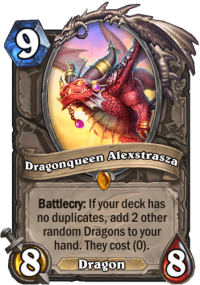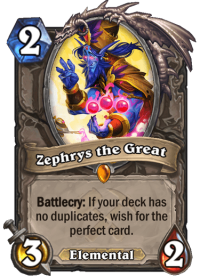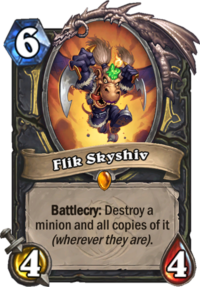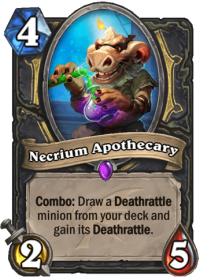Our Highlander Rogue deck list guide goes through the ins-and-outs of this singleton build from Descent of Dragons expansion! This guide will teach you how to the differences between two version of the deck, and how to mulligan and pilot them!
Introduction to Highlander Rogue

A long-running theme of card design in Hearthstone has been the Highlander card, which kicked off with Reno Jackson back in the League of Explorers. The idea here is simple: if you build a deck without duplicates (or go long enough into a game you have drawn them all), you get a card that delivers an exceptional power spike. These spikes ended up being powerful enough to offset the fact that you were playing a much less consistent deck than usual (to the delight of some and dismay of many). In case of Descent of Dragons, while Rogue doesn’t have access to any class-specific Highlander card, it can use two Neutral ones available to everyone – Zephrys the Great and Dragonqueen Alexstrasza, which are already good enough to build a deck around.
Because these decks are inconsistent with large power spikes, they follow two basic principles in their game plan: (a) Draw “The Good Cards” and (b) play the hand that you have, not the hand you want. As you cannot rely on any specific game plan from your deck, you need to aim for a general one, like curving out as any other midrange deck would. If you are offered some specific synergies by the luck of the draw all the better, but your just is to make the best of what you have. You just cannot expect to find any of them in a given game.
So let’s make the best of the situation.
Highlander Rogue Deck List
Check out alternative versions of this deck on our Highlander Rogue archetype page!
Highlander Rogue Mulligan Guide
Keepable vs All Decks
- Necrium Apothecary and Zephrys the Great: These are the “good cards” of the deck. The things that do the most powerful things your deck can. You’re a high-roll deck, so try to roll high.
- Pharaoh Cat and Bloodsail Flybooter: As you are a midrange deck, keeping your best and only 1-drops is a good idea. Cat can activate burgle synergies while both can help you curve, activate combos, and just generally be useful. If you have both, you may only want to keep one in some matches and I’d recommend cat on its own due to the higher tempo it offers. Against faster decks, keep both.
- Seal Fate: There’s nothing special about this card outside of activating some limited synergies – Togwaggle and Galakrond – but it’s something to do in the early game, and that can be good enough.
- Dragon's Hoard: Relatively low on the keepable list, this card simply allows you to do something on turn one that you otherwise might not have while activating hypothetical burgle cards you might draw. There’s also a seemingly-reasonable chance that you can hit something game winning off this for the future, like a Highlander card from another class. Be on the lookout for those.
Keep Conditionally
- Blink Fox: While there’s nothing special about the card – minus its ability to make burgle payoff cards work against non-Rogue – it’s one of your few unconditional early-game drops. It’s not remarkable, but it should do a good enough job. Can keep against everything except Rogue.
- A good curve: Does your hand allow you play cards on turns 1, 2 and 3 or something similar? Feel free to keep it all, as being able to do something for sure isn’t a guarantee in these lists and you cannot dig for a specific game plan.
- Specific synergies: Does your hand offer a specific set of cards that work well together for the match, like Underbelly Fence and Dragon's Hoard? Feel free to keep them.
- Edwin VanCleef/EVIL Miscreant (on Coin): If you have an early combo activator, these are some of the best early-game plays you can make. However, since you cannot guarantee a cheap activator, don’t keep them without a plan.
Keep Vs Aggro
- Backstab: While this is keepable in a variety of matches, it will really shine against decks looking to get early game board control. Against something like Ressurect Priest, for example, the card will be of limited use and would be better served as something proactive.
- Underbelly Fence: Sometimes this will be a 3/4 with Rush for 2 mana, but it usually won’t. However, against an aggressive deck, you want early tempo, and Fence can be good for that even as a 2/3, at least compared to spending that mana to dagger.
- Zilliax: Should be self-explanatory, but aggressive decks don’t like you removing, healing, or Taunting, and this does all three.
Highlander Rogue Gameplay Strategy
You are a Midrange deck and this doesn’t change much on the basis of what you’re up against. Your general goal is to curve out and use your mana each turn as best you can to get minions into play that can hit your opponent in the face repeatedly (or, when you’re against an aggressive deck, your minions can stop their minions from hitting your face first, then hit their face after). When it doubt about which play to make, err on the side of the one that ensures you have more stats on the board than your opponent.

Unfortunately, a more detailed guide than that becomes tricky because of the inconsistent nature of the deck. While it might be nice to have active burgle cards vs other tempo decks, you cannot guarantee it and looking for them too hard can cause you to miss out on the general curve plan. While you might want to fully upgrade a Galakrond, the Nightmare quickly, you only play 3-4 Invoke cards total in the deck, so that’s almost never going to be an option.
The most important part of this deck’s plan, then, is to play the hand you have; not the hand you want. Sometimes it’s going to be right to play that Vendetta for 4 mana or that not upgraded Galakrond because it allows you to spend your mana and do something. If you hold back on tempo, whether for value or synergy later, you’re going to handicap yourself and allow your opponent to get ahead.

The second most important part of this deck is knowing when to use your Zephrys the Great if you have it. In the early game, this can sometimes mean playing it on turn 2 for a Wild Growth to accelerate a slow hand, an Animal Companion to curve out with pressure when you’re the beatdown, or even one of those cards to activate burgle synergies. Maybe you need to save it later in the match for removal or healing. As such, understanding what cards it will offer you on what mana and how it will be best used in a given game is a skill you need to develop. Again, it is difficult to offer a specific guide on how to use it because that use might vary from game to game, depending on what cards you have, what deck your opponent is playing, what options it will provide you, and so on.
Just remember that Zephyrs is the reason to play this deck, so play it wisely. This may involve some trial and error, and learning to read the situation. Thankfully for you, Zephyrs is ludicrously powerful it can bail you out in ways you didn’t even anticipate. Yes, Dragonqueen Alexstrasza is powerful as well, but Zephyrs is the real reason for this deck’s existence. Alexstrasza has mostly one role – be a late game bomb – while Zephrys can fill out for anything you need at the time. Don’t be afraid to experiment with it, because that’s how you learn how to play the card correctly.
Highlander Rogue Card Substitutions
Many cards in this deck are replaceable as the deck does not push towards a specific gameplan. When replacing cards, just bear in mind that they’re often tied to packages within the deck. Notable ones are found below:
- Deathrattle Package: Necrium Blade, Mechanical Whelp, and Anubisath Warbringer are only in the deck because of Apothecary. Dropping any one of those cards will make the others worse (and you probably shouldn’t drop any of them as they’re among the best things this deck does). Don’t add other Deathrattles, like SN1P-SN4P, that can muck up these interactions.
- Galakrond Package: Galakrond, the Nightmare, Kronx Dragonhoof, Praise Galakrond!, Seal Fate, Shield of Galakrond and, if you’re playing it, Devoted Maniac all work together for the same goal and make each other better. However, they also make Heistbaron Togwaggle a playable card where he otherwise wouldn’t be because you wouldn’t have enough Lackey generators. If you don’t have some key part of that package, you might want to consider replacing all of them with something else, like a Hooktusk package of pirates
- Burgle Package: Dragon's Hoard, Blink Fox, Hench-Clan Burglar, Vendetta, and Underbelly Fence all work together (along with Pharaoh Cat to a lesser extent). Removing one of those cards might mean the rest are no longer good enough.
There are, however, some easy-to-replace Legendary cards that are not key: 
- Siamat: This card is fine, but by no means key to the deck’s success. It can be cut for whatever you need, depending on the meta, including cheaper minions, defensive options, or anything of the sort.
- Leeroy Jenkins: A fine burst finisher, but you’re not necessarily a bursty deck.
- Flik Skyshiv: An exceptionally powerful Rogue card that goes into all Rogue decks, but it’s just that: a good card. The deck doesn’t revolve around it and it won’t fall apart without it.
- Edwin VanCleef: See Flik Skyshiv
While the deck may perform better with these cards, removing them doesn’t affect the major synergies of the deck. If you want to add more defensive cards, consider options like Bone Wraith or Lifedrinker. If you want more Lackeys, Devoted Maniac and EVIL Cable Rat can work. Simple removal like Fan of Knives or SI:7 Agent can help control minion-based opponents. Blazing Battlemage can add more early game. Since the meta is different at different ranks etc. you want to add the techs that work best against the decks you face. However you want to tech your list, just make sure you’re aware of which pieces of the deck can be removed without disturbing the others.


I don’t find the “blink fox” card, even in crafting I don’t find it. why?
hi thanks for the great guide i have a question i dont have enough dust for Siamat i should replace him with what
also if its gonna be good idea? if we change the 4 Deathrattle cards with (silence and ooze and Maniac and other removel) conter the meta maybe.
hope u answer me
Yeh I play the deck without the deathrattle cards And I got to rank 2. Deathrattle cards only my opinion slow the game down and it’s annoying when drawing Anubisath or mechanical whelp early game.
So I don’t have Togwaggle is it necessary for the deck. Also is crafting zephrys and Alexstrasza worth it I have the dust but don’t want to waste it on cards that may not see play later on
Zephrys and Alex are safe crafts. Toggwaggle is pretty good though but i think you can do it without it.
For those curious about wild (10-6, ~60%)
I’ve been playing this in wild with a much higher aggro burst focus (cold blood, Lifedrinker, southsea deckhand, ragnaros)
Galakrond is cool, but probably shouldn’t be run in the wild list, there are just more consistent tempo drops for those turns. same thing goes with the anubisath combo.
I dropped reno for more game finishers… as there is no way this deck can compete with the other decks running reno. Zeph + rogue’s high tempo swings, can singlehandly take on aggro decks.
can i switch siamat for tess?
I dont think so, because there are only UP to 5 cards from other classes but only 3 guaranteed (those misc 2 coming from pharaoh and zeph)
Waxadred is probably better because you get some synergy with apothecary
But that synergy is almost negetive compared to welp and warbringer…
Could also try cairne?
I really hate the Necrium Apothecary combo (mostly playing against ofcourse), but this deck is the most fun highlander deck right now. Shadowstep fit so much.
Unlike in Deathrattle build, which really relies on Necrium Apothecary, here it’s just an addition. Deathrattle builds which run 2x Apothecary and 2x Necrium Blade are already pretty inconsistent, this in this case you won’t see the combo in most of your games
But yeah, I agree, Highlander Rogue is pretty fun to play! I like to play Highlander decks in general, because singleton builds often let me have fun with cards that I wouldn’t normally play in other decks.
I’d played some games deck version without deathrattle package, but it was weird not to use most powerfull twsit available in game right now.
Ps: Stonekeep can You recommend any playble highlander MAGE deck?
The best one you can try is Apxvoid’s list: https://www.hearthstonetopdecks.com/decks/highlander-mage-4-legend-apxvoid-descent-post-nerf/
But Highlander Mage is not very strong in Standard right now. Tier 3 deck – playable, especially if you master it, but not as good as other builds.
But if you’re also playing Wild, I’m having a blast with Quest Highlander Mage in there, it’s one of the most fun decks I’ve played in a while!
Thanks for reply. I assume that you’re writting about this one from last article about wilde?
Yep, that’s the one, although I’ve been playing a slightly different build